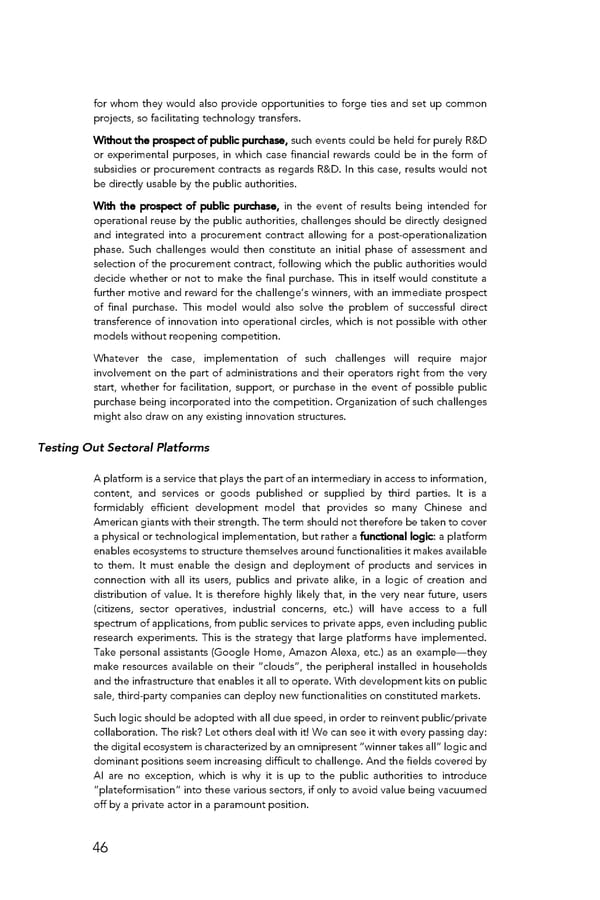for whom they would also provide opportunities to forge ties and set up common projects, so facilitating technology transfers. Without the prospect of public purchase, such events could be held for purely R&D or experimental purposes, in which case financial rewards could be in the form of subsidies or procurement contracts as regards R&D. In this case, results would not be directly usable by the public authorities. With the prospect of public purchase, in the event of results being intended for operational reuse by the public authorities, challenges should be directly designed and integrated into a procurement contract allowing for a post-operationalization phase. Such challenges would then constitute an initial phase of assessment and selection of the procurement contract, following which the public authorities would decide whether or not to make the final purchase. This in itself would constitute a further motive and reward for the challenge’s winners, with an immediate prospect of final purchase. This model would also solve the problem of successful direct transference of innovation into operational circles, which is not possible with other models without reopening competition. Whatever the case, implementation of such challenges will require major involvement on the part of administrations and their operators right from the very start, whether for facilitation, support, or purchase in the event of possible public purchase being incorporated into the competition. Organization of such challenges might also draw on any existing innovation structures. Testing Out Sectoral Platforms A platform is a service that plays the part of an intermediary in access to information, content, and services or goods published or supplied by third parties. It is a formidably efficient development model that provides so many Chinese and American giants with their strength. The term should not therefore be taken to cover functional logic a physical or technological implementation, but rather a : a platform enables ecosystems to structure themselves around functionalities it makes available to them. It must enable the design and deployment of products and services in connection with all its users, publics and private alike, in a logic of creation and distribution of value. It is therefore highly likely that, in the very near future, users (citizens, sector operatives, industrial concerns, etc.) will have access to a full spectrum of applications, from public services to private apps, even including public research experiments. This is the strategy that large platforms have implemented. Take personal assistants (Google Home, Amazon Alexa, etc.) as an example—they make resources available on their “clouds”, the peripheral installed in households and the infrastructure that enables it all to operate. With development kits on public sale, third-party companies can deploy new functionalities on constituted markets. Such logic should be adopted with all due speed, in order to reinvent public/private collaboration. The risk? Let others deal with it! We can see it with every passing day: the digital ecosystem is characterized by an omnipresent “winner takes all” logic and dominant positions seem increasing difficult to challenge. And the fields covered by AI are no exception, which is why it is up to the public authorities to introduce “plateformisation” into these various sectors, if only to avoid value being vacuumed off by a private actor in a paramount position. 46
 For a Meaningful AI - Report Page 46 Page 48
For a Meaningful AI - Report Page 46 Page 48